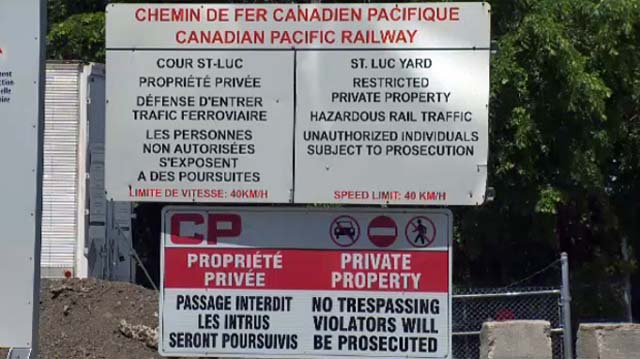

Could Earn CP Half Billion Dollars
Montreal Quebec - Even with the cost of moving the Cote-St-Luc rail yards off the island and decontaminating the 200 hectares of land they sit
on, Canadian Pacific (CP) could make half a billion dollars by relocating them, according to a feasibility study conducted by McGill University graduate
students.
Former west-end politician Robert Libman, who founded the non-profit Coalition for the Relocation of the St-Luc Rail Yards last year, helped push the McGill
study to fruition.
Libman, an architect, estimates the land is worth $1.2 billion, but relocation and decontamination would cost about half that.
However, he noted that decontamination can be supported by government grants.
"The report finds a major cost benefit for CP to relocate the yards," said Libman.
"The potential economic spin offs and benefits far outweigh the cost to CP. They can generate a large profit and help us by doing so."
That help, Libman explains, comes in the form of connecting all the major transportation arteries currently blocked by the yards, while adding to the tax base
with a modern, sustainable, development that keeps families on the island rather than contributing to the urban sprawl that continues to expand outward from
Montreal every year.
However, Cote-St-Luc mayor Mitchell Brownstein takes the study with a grain of salt.
The study, the mayor observed, looks at maximizing profit margins by building a densely populated development that, taking some four decades to complete, would
require the support of local voters and elected officials.
Developments that dense, he said, are "not an easy thing to sell to residents."
Brownstein has been working on this issue for some time, maintaining regular communication with CP's top brass, as he too wants the rail yards to
move.
He said nothing will happen until a deep-pocketed developer steps forward with a serious plan and, he added, CP needs to conduct its own professional,
on-the-ground study that looks at the "real costs" involved.
The students' study was presented to his council last week and Brownstein, noting he is open to citizen and student involvement, has offered to send it along
to CP, but, he added, "We need to work with the main player, which is CP, and not just get media coverage about an idea that some students came up
with."
Brownstein and Libman may not see eye-to-eye on how to encourage relocation, but they both agree that the rail yards need to go.
"We feel in this day and age, to have 22 million square feet of developable land right in the heart of Montreal, when Montreal and other cities are
struggling to combat urban sprawl, doesn't make sense anymore," said Libman, former mayor of Cote-St-Luc and former D'Arcy-McGee MNA.
"When you're able to build a new community from scratch, you can apply a number of environmentally green principles."
The study was conducted by five McGill urban planning students who are set to earn their master's degrees this spring.
One of them, Barrett Hedges, said coming up with exact decontamination costs for such a large parcel of land is difficult because there are no examples of
similar magnitude.
Further studies are needed for an exact figure, he said.
Libman roughly estimated that decontamination would fall in the $70 to $118 million range.
Libman said it is also difficult to quantify moving costs, but the study examines and compares similar rail-yard redevelopments, such as the Angus, Turcot,
Glen, and Outremont yards.
Redeveloping the massive rail yards could open up the west end's access to key routes like Highways 13, 520, and 40, as well as Cavendish Blvd., where an
extension over the tracks has been stuck in the planning stage for several decades, he said.
Libman said the study proposes breaking up the land into five separate development zones, with a mix of housing, institutional, and recreational
spaces.
The hope, he added, is that the feasibility study will encourage the various levels of government to create enough incentive for CP to relocate.
Calling their group the Roundtable Studio, the students included Hedges, Zoe Chapin, Lesley Fordham, Adrian Phillips, and Tori Steeves.
The 98 page study took three and a half months to complete.
Chapin said the proposal integrates some existing structures like the historic roundhouse.
In the plan, the crescent-shaped building serves a town centre and is called the "Roundhouse Plaza".
Steeves said, "I think this study represents a really dynamic vision and it has a lot of potential to keep families on the island of Montreal and foster a
green, sustainable, future that extends Cote-St-Luc and sets a nice foundation in a gaping hole that exists right now."
On its website, CP provides a statement about rail relocation, inviting studies from the community.
The statement concludes, "An extensive review would need to take place to determine the impact to customer service and the full cost to all stakeholders,
which will be significant."
When contacted about this issue, CP spokesperson Salem Woodrow stated in an email, "CP has not received or reviewed the report. CP looks forward to
providing feedback on the report once received and reviewed."
Author unknown.
of the Canadian Copyright Modernization Act.


